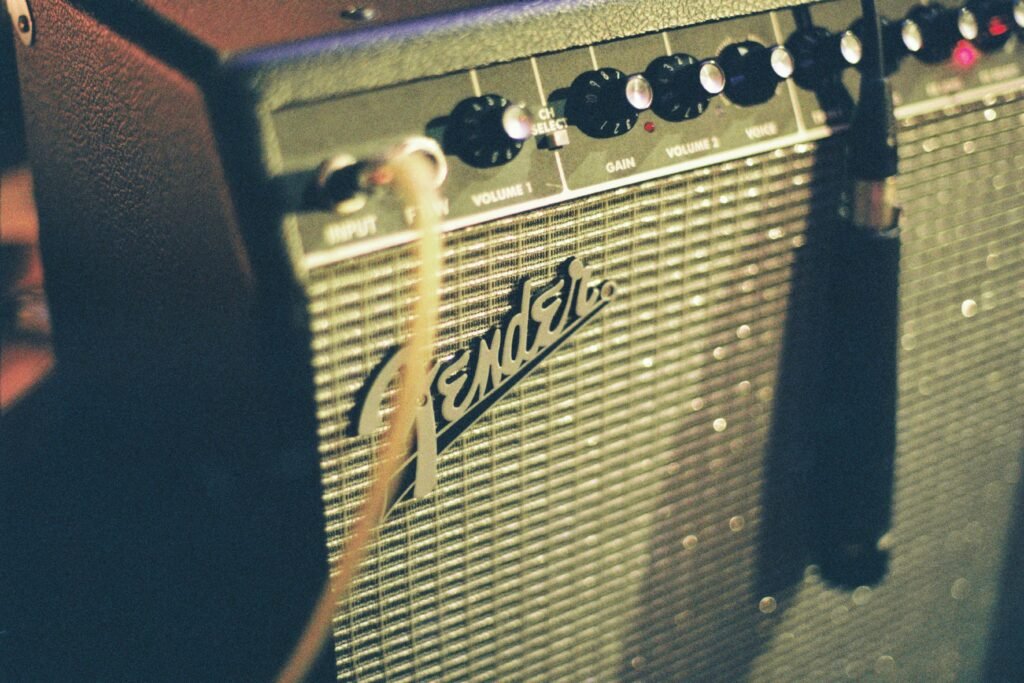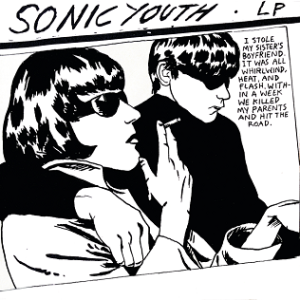Released in June 1990, Goo marked a significant moment in Sonic Youth’s discography and the broader alternative rock landscape. It was the band’s first major-label release, signaling a shift from the underground, independent ethos they had championed in the 1980s, to a larger, more commercial platform. Yet, despite this transition to Geffen Records, Sonic Youth didn’t abandon their core artistic values—if anything, Goo amplifies the noisy, experimental edge that had defined their sound, while offering more accessible structures and a sharper sense of cultural critique.
Artistic Intentions
Coming off the experimental success of 1988’s Daydream Nation, which solidified their standing as underground icons, Goo expands on the dissonant guitars, non-linear song structures, and subversive lyrics, but with a newfound confidence and reach. While not a radical departure from their earlier work, Goo refines Sonic Youth’s fusion of art-punk sensibilities with the burgeoning alternative rock scene of the early ’90s, prefiguring the grunge explosion that would soon sweep the mainstream.
Artistically, Goo reflects Sonic Youth’s intention to straddle two worlds—remaining true to their avant-garde roots while engaging a broader audience. The album explores themes of media consumption, identity, and youth rebellion, often laced with a critical edge. Songs like “Kool Thing” interrogate pop culture and gender politics, a reflection of the band’s fascination with both the allure and emptiness of fame and consumerism.
In interviews around the album’s release, the band frequently emphasized their desire to challenge the boundaries of rock music while retaining a DIY, outsider perspective, even within the machine of the major-label system. In this sense, Goo represents an evolution rather than a departure—both an exploration of new possibilities and a deepening of the band’s artistic mission.
Sonic Exploration

Goo stands as a testament to Sonic Youth’s ability to push sonic boundaries, marrying raw experimentation with more accessible structures. The album’s production—handled by Nick Sansano, alongside the band and producer Ron Saint Germain—captures a delicate balance between clarity and grit. While the production is cleaner than their previous, more lo-fi work on SST Records, it doesn’t smooth over the band’s signature chaos. Instead, the album retains a deliberately unpolished edge, mirroring the fragmented, sometimes abrasive emotions the music conveys. There’s a noticeable shift towards tighter song structures, but Goo remains infused with the fuzzed-out, dissonant guitar tones and clattering rhythms that made Sonic Youth pioneers of noise rock.
Musical Arrangements
One of the most compelling aspects of Goo’s sonic palette is the way it layers both subtle and jarring textures. The interplay between Thurston Moore and Lee Ranaldo’s guitars remains central to the band’s sound, weaving together melodic lines with discordant feedback, creating a tension that propels the album forward. Tracks like “Dirty Boots” feature more straightforward alt-rock arrangements with jagged undercurrents, while “Mote” pushes further into the avant-garde with swirling feedback loops that dissolve into an almost chaotic soundscape by the song’s end. Kim Gordon’s bass often anchors the otherwise fragmented, freewheeling guitar work, while Steve Shelley’s drumming provides a steady, primal backbone that feels both organic and disciplined, particularly evident on tracks like “Disappearer.”
Vocally, Goo leans into a more experimental dynamic as well. Gordon’s detached, half-spoken delivery on “Kool Thing” and “Tunic (Song for Karen)” conveys a sense of cool rebellion, perfectly matching the album’s themes of cultural disillusionment and resistance. Moore’s vocal presence on tracks like “Mary-Christ” adds an almost sneering irreverence, contrasting sharply with the album’s more introspective moments. The band’s use of vocal interplay, as on “My Friend Goo,” where Gordon and Moore trade lines, enhances the feeling of chaotic energy that pulses through the record.
Genre Elements
In terms of genre, Goo straddles multiple worlds. The album remains rooted in the post-punk and noise rock traditions Sonic Youth helped pioneer, but there’s an undeniable flirtation with the rising alternative rock scene. Sonic Youth incorporates elements of punk’s raw energy, the angularity of no wave, and even traces of proto-grunge, particularly in the fuzzed-out guitar work. “Kool Thing,” with its collaboration with Chuck D of Public Enemy, blends noise rock with hip-hop influences—a bold crossover that speaks to the band’s willingness to experiment with genre boundaries. This blending of styles, rather than fully committing to a single one, allows Goo to feel constantly innovative, bridging underground art-rock with a burgeoning mainstream aesthetic.
Lyrical Analysis

Lyrically, Goo stands as a reflection of Sonic Youth’s fascination with the tensions between mainstream culture and underground sensibilities. The album explores a range of themes—from disillusionment with fame and media, to introspection on identity, rebellion, and alienation. These themes are often expressed through cryptic, fragmented lyrics that blur the line between poetry and stream-of-consciousness storytelling, creating a sense of abstraction that invites multiple interpretations.
Themes
One of the album’s central thematic threads is a critique of celebrity culture and the commodification of art and identity. This is especially apparent in “Kool Thing,” where Kim Gordon confronts both gender politics and pop culture’s superficiality. The song famously references an imagined dialogue with LL Cool J, in which Gordon’s deadpan vocals ask, “Are you gonna liberate us girls from male, white, corporate oppression?”
Here, the lyrics seem to tackle the intersection of feminism and celebrity, offering a pointed critique of the music industry’s patriarchal structures while maintaining a playful edge. This juxtaposition of biting social commentary with a punk rock sneer is a hallmark of Goo’s lyrical style, challenging listeners to engage with its layers of meaning.
Another recurring motif in Goo is the exploration of personal identity and mental disintegration. “Tunic (Song for Karen)” is perhaps the most haunting example, where Gordon sings from the imagined perspective of Karen Carpenter, reflecting on the tragic consequences of societal pressures and internalized expectations. “Hey mom! Look, I’m up here, I finally made it, I’m playing the drums again,” Gordon sings with a mix of ghostly detachment and childlike longing, offering a chilling commentary on fame and its emotional toll. The song’s lyrics, though minimalist, evoke a profound sense of loss, frustration, and the search for solace—both from external forces and within oneself.
Lyrical Depth
Sonic Youth’s approach to lyricism on Goo is often more impressionistic than narrative-driven. Songs like “Disappearer” and “Mote” feature cryptic, sometimes surreal imagery that serves more to evoke mood than to tell linear stories. “Disappearer” touches on themes of alienation and escape, but its meaning remains elusive, wrapped in lines like, “There’s no here, he’s disappeared, what can I do?” This kind of lyrical ambiguity is a key feature of the album, as Sonic Youth eschews straightforward narratives in favor of fragmented, poetic snapshots that reflect the disjointedness of modern life.
Despite their abstract nature, the lyrics on Goo carry a strong emotional weight. Whether through Kim Gordon’s cool, disaffected vocal style or Thurston Moore’s detached delivery, the album communicates a sense of both disillusionment and yearning. The emotional impact is subtle but potent—Goo doesn’t strive to provoke overt empathy or sadness; instead, it evokes a more introspective, contemplative response. Songs like “Mildred Pierce” and “Mary-Christ” offer sharp, abrasive lyrical vignettes that align with the album’s punk rock ethos, creating moments of anger and rebellion. At the same time, the more introspective tracks, like “Tunic” or “Disappearer,” tap into a deeper well of existential anxiety, leaving the listener to grapple with feelings of isolation and disconnection.
Cohesion and Flow

Goo showcases Sonic Youth’s ability to craft an album that feels cohesive yet unpredictable, balancing thematic and sonic consistency with moments of deliberate disruption. The track progression on Goo is less about following a traditional narrative arc and more about creating an emotional and sonic landscape that shifts between chaos and clarity. Rather than a linear journey, the album feels like a series of interconnected vignettes, each contributing to the overall mood of alienation, cultural critique, and rebellion.
Track Progression
The album opens with “Dirty Boots,” a track that immediately sets the tone with its mix of accessible alt-rock energy and underlying dissonance. It serves as a gateway into Sonic Youth’s world, where catchy melodies coexist with jagged edges. This is followed by “Tunic (Song for Karen),” which takes the listener into darker, more introspective territory. This early shift—from the propulsive energy of “Dirty Boots” to the melancholic detachment of “Tunic”—creates a compelling emotional contrast that becomes a recurring dynamic throughout the album. As the listener moves from track to track, Sonic Youth continually toggles between moments of tension and release, crafting an experience that feels fluid but never predictable.
Tracks like “Kool Thing” and “Disappearer” anchor the middle of the album with strong thematic continuity. Both songs tap into critiques of celebrity and media culture, but where “Kool Thing” adopts a confrontational swagger, “Disappearer” offers a more introspective meditation on disconnection and escape. This contrast keeps the listener engaged without disrupting the album’s flow. Even with the vastly different tones of these songs, they are tied together by Sonic Youth’s signature interplay of noise and melody, which gives the album a sense of sonic coherence even when the themes shift.
Break of Flow
While the thematic and emotional consistency of Goo is impressive, there are moments where the band intentionally breaks the flow, injecting bursts of chaos into the mix. “Mildred Pierce” is a brief but blistering noise-rock explosion, with screeching guitars and primal screams that feel almost like a sonic outburst. While it may seem jarring at first, the track serves to disrupt the album’s rhythm in a way that mirrors its punk ethos, reminding the listener that Sonic Youth’s art is as much about tension and discomfort as it is about melody or lyricism. This kind of disruption is a hallmark of Sonic Youth’s style—challenging the listener by refusing to settle into one mood or genre for too long.
The latter part of the album, particularly with tracks like “Cinderella’s Big Score” and “Titanium Exposé,” reintroduces the balance between chaos and structure. “Cinderella’s Big Score” has an aggressive, punk-infused edge, while “Titanium Exposé” closes the album with a more epic, almost cinematic feel. This final track serves as a fitting conclusion, bringing the listener full circle from the sharp edges of earlier tracks to a broader, more expansive sound that suggests both catharsis and unresolved tension. It’s a conclusion that reinforces Goo’s overall themes of resistance and ambivalence, leaving the listener in a state of contemplation rather than providing a tidy resolution.
Thematic Consistency
In terms of thematic consistency, Goo excels at maintaining its core ideas—alienation, media critique, identity, and rebellion—across all of its songs. Even as the soundscape shifts from noise-laden breakdowns to more structured, melodic moments, the album never loses sight of its message or mood. There’s an inherent unity in the way Sonic Youth approaches their music, with their signature dissonance and abstract lyricism tying the album together, ensuring that even the most jarring shifts feel intentional. Rather than offering smooth transitions or predictable emotional progressions, Goo thrives on its ability to move between extremes, creating a sonic and emotional journey that feels cohesive in its chaos.
Standout Tracks and Moments
Goo is filled with tracks that showcase Sonic Youth’s unique ability to blend artistic experimentation with moments of raw emotional power. While the album as a whole represents a cohesive statement, several key tracks stand out for their innovation, thematic depth, and emotional resonance.
Kool Thing
“Kool Thing” is perhaps the most iconic track on the album, and for good reason. Its infectious guitar riff and confrontational lyrics cement it as a feminist anthem of the 1990s. Kim Gordon’s half-spoken, half-sung delivery takes aim at the misogyny embedded in pop culture and celebrity worship, and the addition of Chuck D from Public Enemy creates a memorable crossover between alternative rock and hip-hop.
The interplay between Gordon’s deadpan vocals and Chuck D’s deeper, commanding presence adds a layer of tension to the song’s critique of media, identity, and gender politics. One of the most memorable moments comes when Gordon poses the pointed question, “Are you gonna liberate us girls from male, white, corporate oppression?” The line captures the essence of Goo—cool, cutting, and critical, while still wrapped in the band’s trademark dissonant sound.
Tunic (Song for Karen)
“Tunic (Song for Karen)” stands out for its emotional impact and haunting subject matter. A tribute to Karen Carpenter, it channels the tragedy of Carpenter’s life and early death, offering a poignant critique of the pressures of fame, body image, and control. Kim Gordon’s wistful, ghostly vocals glide over a sparse, unsettling backdrop, evoking a sense of loss and longing. The line, “I’m stuck here, I got nothing to live for,” chills with its subtle vulnerability, creating a stark emotional contrast to the band’s typically detached tone. The song’s ethereal quality and its deep empathy for a fallen pop icon make it one of the album’s most emotionally affecting tracks.
Dirty Boots
“Dirty Boots” opens the album with an explosive mix of melody and noise, immediately signaling Sonic Youth’s fusion of accessibility and chaos. It’s a perfect gateway into Goo, balancing a driving rock beat with their signature dissonant guitar interplay. The track’s dynamic structure—building from a catchy, almost pop-like riff into a sprawling, noisy outro—sets the tone for the rest of the album. The outro, where the guitars devolve into a wash of feedback and distortion, captures the band’s experimental spirit while still retaining a sense of melody and rhythm, a hallmark of Goo’s sound.
Mote
“Mote” is another standout, largely thanks to Lee Ranaldo’s frenetic performance. The song begins with a deceptively simple, almost upbeat structure, before spiraling into a noise-driven vortex by the halfway point. Ranaldo’s vocals, which oscillate between a dreamlike calm and a rising tension, enhance the song’s gradual descent into sonic chaos. The instrumental breakdown—a swirling mass of feedback, distorted guitars, and reverb—serves as a powerful moment on the album, showcasing Sonic Youth’s ability to create atmospheric depth while abandoning traditional song structures. The track is a testament to the band’s more avant-garde tendencies, turning noise into an art form.
Memorable Moments
Memorable Moments across Goo often arise from the band’s fearless use of unconventional sonic elements. One such moment is the brutal, shrieking breakdown in “Mildred Pierce.” The track begins with an unsettling build, driven by a minimalist guitar line, before erupting into a primal scream that obliterates any sense of control. It’s a moment that strips the album down to its rawest form, where noise and emotion collide in a visceral outburst of anger and release. This track, although brief, embodies the punk spirit of Goo—refusing to conform, opting instead to unsettle and challenge the listener.
Another striking moment is the noisy crescendo at the end of “Titanium Exposé,” the album’s closing track. After building tension with driving guitars and hypnotic rhythms, the song dissolves into a sonic explosion that mirrors the chaotic energy introduced in the opening tracks. This climactic breakdown brings Goo to a full-circle conclusion, leaving the listener in a state of suspended chaos—a fitting end to an album that thrives on balancing the controlled with the unpredictable.
Artistic Contribution and Innovation

Goo occupies a pivotal place not only in Sonic Youth’s discography but also in the evolution of alternative rock and the wider music industry of the early ’90s. Released at a time when the underground was beginning to seep into the mainstream, Goo helped bridge the gap between noise rock’s avant-garde experimentation and the burgeoning alternative scene that would soon explode with the rise of grunge. In this sense, the album both pushed boundaries and played a crucial role in ushering underground sounds into the mainstream, without compromising the band’s rebellious, non-conformist ethos.
At the time of its release, alternative rock was still on the fringes of popular culture, and signing with a major label like Geffen Records was seen as a risky move for a band as fiercely independent as Sonic Youth. Yet, rather than dilute their sound to fit commercial expectations, Goo pushed boundaries by bringing noise rock’s dissonance, feedback, and experimental structures to a broader audience. Tracks like “Mote” and “Mildred Pierce,” filled with swirling feedback and chaotic breakdowns, exemplified the band’s commitment to sonic innovation, refusing to tone down their raw edge despite the pressures of a major-label release.
This major-label jump was not a compromise—it was an expansion of their creative vision on a larger platform, setting a precedent for other underground bands to follow. In this way, Goo helped lay the groundwork for the explosion of alternative and grunge acts in the early ‘90s, from Nirvana to Smashing Pumpkins, who would go on to dominate the mainstream.
Innovation
Sonic Youth’s approach to genre on Goo was equally innovative. By blending elements of punk, noise rock, post-punk, and even hip-hop (as seen in their collaboration with Chuck D on “Kool Thing”), the album pushed genre boundaries, reflecting the band’s refusal to be pigeonholed. This genre fluidity was groundbreaking in 1990, as most bands were expected to fit neatly into established categories. Instead, Goo expanded what alternative rock could be—incorporating jagged, atonal guitars, free-form song structures, and socially conscious, subversive lyrics, all while maintaining a semblance of melody and structure that made their music more accessible without losing its edge.
Themes
Thematically, Goo stands out for its incisive cultural critique. At a time when the media-driven machine of fame and consumerism was becoming more pervasive, Sonic Youth used Goo as a platform to question and undermine these forces. Songs like “Kool Thing” and “Tunic (Song for Karen)” tackle gender politics, fame, and societal pressures in ways that were rarely addressed so explicitly in rock music at the time. Kim Gordon, in particular, became a vocal presence for feminist perspectives within the male-dominated alternative scene, lending a fresh and confrontational voice to the genre. Her cool, detached delivery combined with biting, intellectual lyrics was innovative, adding a layer of depth to Goo’s commentary on fame, femininity, and exploitation in the media.
Production
In terms of production, while Goo features a cleaner, more polished sound than some of Sonic Youth’s earlier work, it still retains their signature abrasiveness. The production allowed for greater clarity without sacrificing the band’s experimental edge, showcasing their ability to blend accessibility with dissonance. The use of extended feedback loops, alternate guitar tunings, and unconventional song structures was still very much present, but these elements were balanced with a more focused and immediate sound, making the album feel fresh and groundbreaking even within the constraints of major-label production. Goo doesn’t abandon the raw DIY energy of its predecessors, but rather refines and sharpens it, bringing that underground ethos to the masses.
Perhaps one of Goo‘s most enduring innovations is the way it opened doors for other experimental and noise-rock bands to cross into mainstream consciousness. By successfully transitioning to a major label without sacrificing their avant-garde approach, Sonic Youth demonstrated that underground music could thrive in a broader market. This shift proved that there was a hunger for music that challenged conventions, both sonically and thematically, influencing not just their contemporaries but entire movements within the alternative rock landscape.
Closing Thoughts

Goo remains one of Sonic Youth’s most influential albums, a bold venture into major-label territory that still retains the gritty, avant-garde spirit that made the band underground icons. Its strengths lie in its ability to balance accessibility with experimentalism, offering a gateway for new listeners while continuing to challenge musical conventions. The album’s standout tracks, such as “Kool Thing” and “Tunic (Song for Karen),” showcase the band’s sharp social commentary, while its noisier moments—like “Mote” and “Mildred Pierce”—keep their commitment to sonic chaos intact. The seamless blending of noise rock, alternative, punk, and even hip-hop elements reflects the band’s willingness to break boundaries, and Goo represents a defining moment in the intersection of underground and mainstream music.
Weaknesses
However, while Goo is undeniably groundbreaking, it is not without its imperfections. Some listeners might find its more abstract moments alienating or disorienting, and tracks like “Mildred Pierce” or the feedback-laden breakdowns can feel a bit abrasive if one is unprepared for Sonic Youth’s chaotic tendencies. At times, the experimental noise elements may overshadow the lyrical depth, making it harder for listeners to connect emotionally with the themes. This tendency for abstraction, while essential to Sonic Youth’s artistry, can leave certain tracks feeling disconnected, especially when contrasted with the more structured songs like “Dirty Boots.”
That said, these minor weaknesses don’t detract from the album’s overall impact. Goo succeeds in expanding the reach of alternative music without compromising the band’s artistic integrity, making it a vital part of both Sonic Youth’s discography and the larger story of 1990s alternative rock. Its legacy is one of influence, inspiring countless bands to explore the tension between noise and melody, chaos and control.
Official Rating
As a final rating, I would give Goo an 8/10. While it isn’t without its rough edges, these imperfections are part of what makes the album so distinctive. It might not be as universally accessible as some of Sonic Youth’s later work, but Goo’s blend of raw experimentation and cultural critique gives it a lasting power. For fans of alternative music and those willing to engage with its layered complexities, Goo remains an essential listen—a daring and boundary-pushing album that captures Sonic Youth at a transformative moment in their career.
